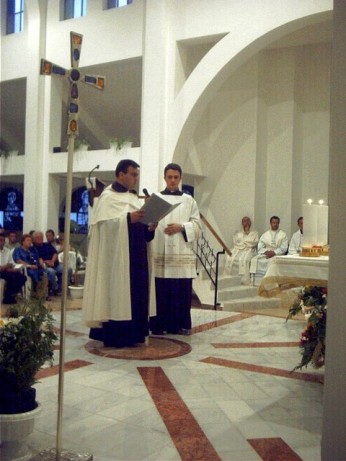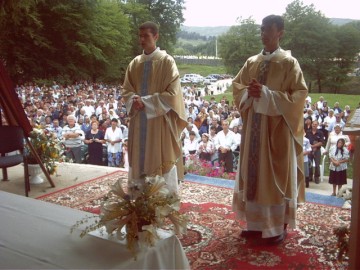|
no. 3 july - september 2003
The liturgical celebration of Our Lady of Mount Carmel on July 16 was solemnly celebrated in the Carmelite monastery of Luncani (Romania) for the first time. It was also the first time the feast was held in the Diocese of Iasi and perhaps anywhere in Romania. Msgr. Stefan Erdes, the area dean, presided at the liturgy, which was held in the open air. The first Romanian Carmelite priest, Iosif Farcas, outlined the history and the spiritual significance of the event in his homily. Many diocesan priests and the two newly ordained Carmelites participated as concelebrants. Numerous faithful attended even though it was a workday and many had to travel quite a distance. After the celebration, the priests, the ministers, and the Carmelites in white cloaks, took part in a short processions with the original Byzantine icon of Our Lady of Mount Carmel. This was followed by traditional prayers and the clothing of the faithful in the scapular. A catechesis on the meaning and value of the scapular had been done previously during a novena led by the two newly ordained Carmelites. It was repeated in a shorter form on the day of the celebration. The local Carmelite community has for some time reflected on how to make this sacramental known, in an adequate way, to the people as it is known to the rest of the Church. The scapular was presented as the mantle of the Mother of God, very clearly illustrated by the icon created specifically for the new monastery in Luncani and reproduced in a large mosaic in the church. The Virgin, seated on a throne and under the symbolic Divine Hand, with Jesus on her arm, has her mantle in her left hand covering some of the important saints and blesseds of the Carmelite family in the 20 th century: Titus Brandsma, Isidore Bakanja, Edith Stein, and Anicka Zelikova.The possibility of protection under the mantle of the Mother of God, ancient and very much alive in eastern spirituality, testified to by Maximos the Confessor, and traditionally represented in the icons of the slavic world, is being used to show the convergence of the Carmelite tradition and the rich heredity of eastern spirituality. The blessed scapulars, in fact, carry the image of the icon on one side and that of the Prophet Elias on the other, both being patrons of the monastery. Also important is the fact that the people are receiving the scapular in a center promoting a particular spirituality, avoiding falling into superstitions which is always a danger in popular piety. A brochure was also distributed that reproduces the two icons, explains the meaning of the ‘mantle of Mary," contains two prayers as well as practical explanations of the devotions. It also contains the name of the person, the date and signature of the Carmelite priest who enrolled them in the scapular. The idea of participating in the spiritual benefits of the Carmelite Order as a result of wearing the scapular is important. For the first time, the Romanians are personally receiving a scapular from a Romanian Carmelite priest and they were willing to stand patiently in a line of more than 500 people. On the following Sunday, the Carmelite monastery of Lucani celebrated the feast of the prophet Elijah who passed his mantle to the prophet Elisha and that celebration was another opportunity for the people to receive the scapular.
Pope John Paul II and the Feast of Our Lady of Mount Carmel At his usual Wednesday audience on July 16, held at his summer residence in Castelgandolfo, Pope John Paul II addressed a group of Polish pilgrims about the Feast of Our Lady of Mount Carmel. "Today, in the liturgy, is the memorial of Our Lady of Mount Carmel. This memorial is particularly important to all those devoted to the Madonna of Carmel. I also, from the time of my youth, have worn the scapular of Our Lady and I find comfort under the mantle of the Blessed Virgin Mary, Mother of Jesus," the Pope said. "I fervently hope that the scapular, a sign of peace and the motherhood of Mary, will be a help and protection in times of danger for all who wear it." At the end, the Pope greeted the young people, the sick, and the newly married couples, saying "The memorial in today’s liturgy, of Our Lady of Mount Carmel, offers me the opportunity to remind you of Mary as a model which we can refer, to find in her an example of inspirtation and sure guide. I exhort you to always invoke her as a comfort and hope." The Carmel scapular was not the full extent of Karol Wojtyla’s connection with Carmelite spirituality. He gave serious thought to entering the Carmel, after reading the works of St. John of the Cross. The Spanish saint’s mystical writings so moved the future Pope that he based his doctoral thesis in theology on them. World Congress to Mark Anniversary of Thérèse of Lisieux The Cardinal Suenens Center of Cleveland, Ohio, has announced that a World Congress will be held in Rome on St. Thérèse of Lisieux, to mark the fifth anniversary of her declaration as a doctor of the Church. The Congress will be at the Pontifical Gregorian University and will include two Carmelites as presenters. "Thérèse of Lisieux: Her Message for Today" is the motto of the Congress, which will be held Nov. 10-11, 2003. The Congress, which is free and open to all, will be in Italian and English. Among the scheduled participants will be Cardinal Godfried Danneels, Archbishop of Brussels-Malines, and Cardinal James Francis Stafford, president of the Pontifical Council for the Laity. Carmelites Christopher O’Donnell (Hib) and John Welch (PCM) will also be participating. Christopher will be one of two respondents to Conrad de Meester’s keynote address titled "Thérèse of Lisieux: Living Theological Genius." He will later deliver a paper on "Discernment and Spiritual Direction: Theological Insights from Thérèse." John will deliver a paper on "Thérèse and the Power and Mystery of Suffering." Auxiliary Bishop Patrick Ahern of New York, a noted scholar on Thérèse, will also participate. An Interesting Museum Project: The Image of Devotion For 20 years, during trips to various parts of the world, Carmelite Carmelo Cox managed to collect an interesting assortment of sacred statues. His goal was to create a collection of sculptured figurines of God, the saints, and angels for use in catechesis. The approximately 1200 pieces, collected by Cox and now maintained in the Carmelite monastery of Lapa (Rio de Janeiro, Brazil), present a wide range of figurines. Alongside works of great artistic value and refined details are many other pieces by lesser known artists and commercial pieces- 18th century sculptures coexist with very recent pieces. A project has begun in the Rio Province to create a museum dedicated to local piety and popular devotion, beginning with the collection of sacred images collected by Cox. Not incidently the museum has been dedicated with the name "Museu de Imaginárias" (The Museum of Images). The work has been given to curator Thelma Palha, who worked at the Museum of Aleijadinho in Ouro Preto. The purpose of the museum is to present the iconographia of religion. "We intend this project to recall, by means of the pieces on display in the museum, the history of the Catholic religion." The museum will be divided into various displays. The first of these displays will be on the iconography of the Holy Trinity, of the angels, and of the life of Jesus (scenes of his birth, baptism, and passion). In the second area will be the saints: the founders of the religious orders, the black saints, the evangelists, the martyrs, etc. A third display will contain the works portraying the Virgin Mary under various titles, among which will be that of Our Lady of Mount Carmel. In only six months, some 600 images and sculptures have been chosen based on the artistic and value as well as their importance in popular devotion. In 2002 a show, entitled "Faces," was organized, dedicated to the Madonna. At the center of the exposition were three curious images: an Annunciation in which Mary and the Archangel Gabriel have their eyes closed (a Spanish work from the XVI century), a rare scene of the circumcision of the Infant Jesus (a German work from the XVIII century), and a Madonna of the Good Death (representing a dying Mary). There were also images and statues of the Madonna in porcelain, finely painted but without artistic value but definitely of devotional interest. In July a display of Our Lady of Mount Carmel was held. Others are being planned.
|
||||
|
RETURN TO THE INDEX FOR 2003 | RETURN TO THE INDEX FOR THIS ISSUE INDEX OF CARMELITE
WEBSITES |

